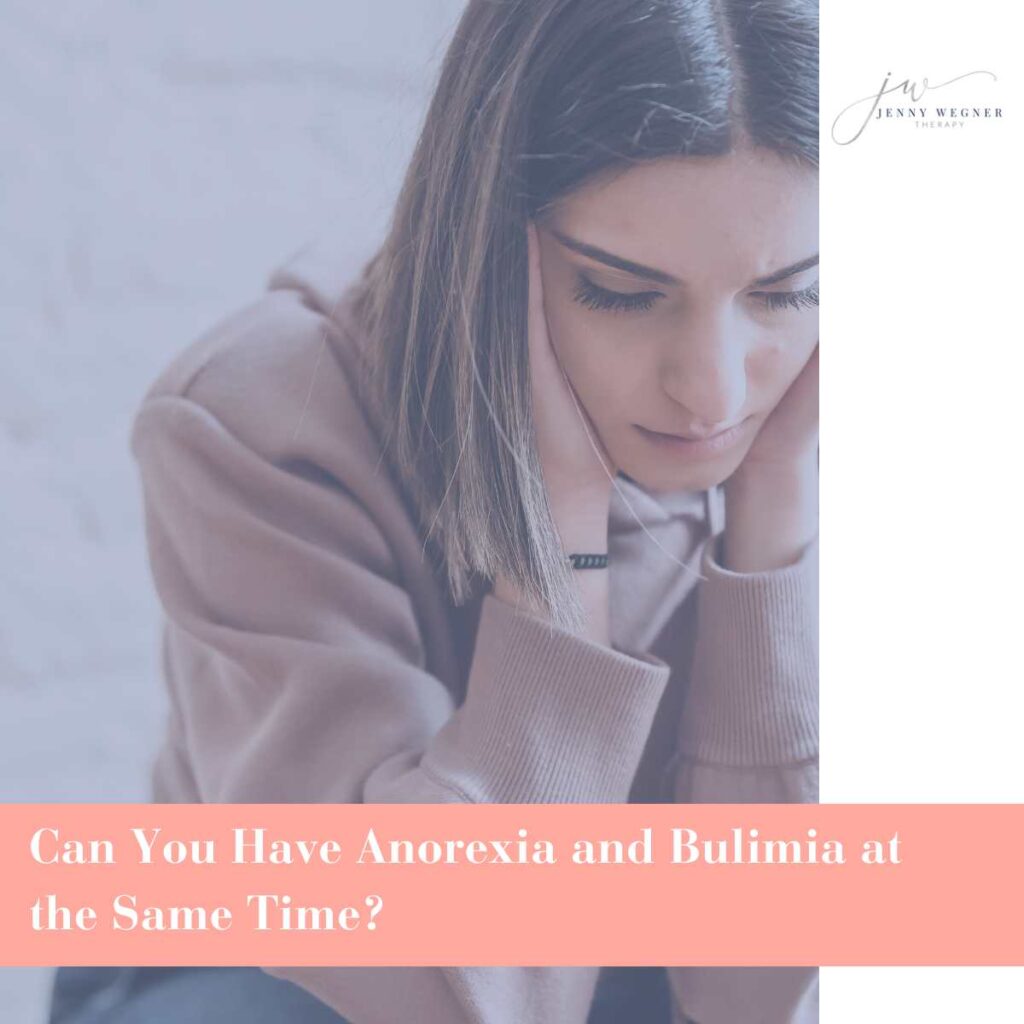I still remember this beautiful client of mine with tears streaming down her face. “I don’t understand what’s happening to me,” she whispered. “Some days I barely eat anything. Then suddenly I’m binging and purging. How can I have both? Am I just making this all up?”
After 17 years as an eating disorder therapist, I’ve heard this question countless times. The confusion is real, and it deserves a thoughtful answer.
The truth is that eating disorders rarely fit into neat diagnostic boxes. Our healing journeys are as unique as we are—messy, complex, and often overlapping. And yes, you absolutely can experience anorexia and bulimia simultaneously.
Let’s explore this reality together—gently, honestly, and with the nuance it deserves.
The Reality of Coexisting Eating Disorders of Anorexia and Bulimia

Eating disorders rarely exist in isolation or remain static throughout our lives. Multiple eating disorders can appear simultaneously, with anorexia nervosa and bulimia nervosa representing the most frequent co-occurrence.
While these disorders are categorized separately in diagnostic manuals, the lived experience tells a different story. Their symptoms exist on a spectrum, with many people experiencing both restrictive and binge-purge behaviors at different times.
I’ve sat with countless clients whose eating disorder shifted and evolved—sometimes within the same day. One moment, the intense fear of weight gain and restrictive patterns dominate (hallmarks of anorexia), and hours later, the overwhelming urge to binge and purge takes over (characteristic of bulimia).
This isn’t confusion or weakness. It’s the complex reality of how eating disorders manifest.
The Clinical Understanding of Dual Diagnosis
The medical community recognizes this overlap. Research consistently shows significant symptom crossover and frequent diagnostic shifts between eating disorders.
In fact, diagnostic manuals now include an “anorexia nervosa-binge eating/purging subtype,” which acknowledges bulimic behaviors within an anorexic diagnosis.
The numbers speak volumes about this overlap:
- Between 8-54% of individuals with anorexia develop bulimia
- Approximately 4-27% of those with bulimia develop anorexia
- This diagnostic crossover typically occurs within the first five years of illness
- Research suggests that 20-50% of anorexia patients will develop bulimia over time
These statistics reflect something I’ve witnessed countless times in my practice—eating disorders are rarely static conditions. The boundaries between them are fluid, not fixed.
How They Manifest at the Same Time
When someone experiences both anorexia and bulimia, their symptoms might appear in different patterns:
- Alternating periods: Severe food restriction (characteristic of anorexia) alternating with episodes of binge eating followed by purging behaviors (characteristic of bulimia).
- Cycling patterns: Periods of extreme caloric restriction interspersed with binge eating episodes without compensatory behaviors.
- Simultaneous symptoms: Fear of weight gain and body image disturbance (anorexic features) alongside regular binge-purge cycles (bulimic features).
A client once described it to me as “living with two tyrants in my head who take turns being in charge.” Some days, the anorexic voice dominated—ruthlessly restricting, counting, measuring. Other days, the bulimic patterns took over—the overwhelming urge to binge followed by desperate compensation.
Both voices were different expressions of the same underlying pain.
Beyond Behavior: The Shared Roots of Anorexia Bulimia

The overlap between anorexia nervosa and bulimia nervosa isn’t merely behavioral—it has biological underpinnings. Recent genetic studies provide compelling evidence for shared biological mechanisms.
Twin and sibling studies have revealed significant genetic correlations between these disorders:
- A statistical genetic correlation of 0.66 between clinically diagnosed anorexia nervosa and bulimia nervosa
- Environmental correlations of 0.55 between the disorders
- The overlap between these disorders is approximately equally explained by genetic and environmental factors
Beyond genetics, several psychological factors contribute to this overlap:
- Shared psychological traits like body image dissatisfaction, low self-esteem, and perfectionism
- Common environmental triggers including societal pressures and personal traumas
- The restrictive eating patterns present in both disorders—as dietary restriction can trigger both further restriction (anorexia) and compensatory binge episodes (bulimia)
- Cycles of shame and guilt that perpetuate both disorders
I’ve observed this in therapy rooms for years. The perfectionism that drives restriction can also trigger the shame spiral after perceived failures that leads to binging. The body dissatisfaction that fuels purging behaviors often coexists with the fear of weight gain that characterizes anorexia.
These shared factors help explain why individuals often experience symptoms of both disorders simultaneously or transition between them over time.
The Complexity of Comorbidity:
The clinical complexity of dual eating disorder diagnosis is further complicated by high rates of other conditions. In my practice, I rarely see eating disorders existing in isolation.
Both anorexia nervosa and bulimia nervosa frequently co-occur with mood and anxiety disorders:
- Major depressive disorder occurs in 50-70% of anorexia nervosa patients and 50-65% of bulimia nervosa patients
- Anxiety disorders are present in 24-71% of anorexia nervosa patients and 57-75% of bulimia nervosa patients
- Obsessive-compulsive disorder (OCD) appears in 35% of restricting anorexia patients, 44% of binging/purging anorexia patients, and 40% of bulimia patients
The relationship between eating disorders and substance use disorders is particularly noteworthy:
- Substance use disorders are present in 12-18% of anorexia nervosa patients and 30-70% of bulimia nervosa patients
- Up to 50% of individuals with an eating disorder use alcohol or illicit drugs, compared to approximately 9% in the general population
- Alcohol use disorders are significantly more prevalent in women with both anorexia and bulimia or bulimia alone compared to women with anorexia alone
These overlapping conditions often complicate both diagnosis and recovery. I’ve sat with clients who used substances to manage anxiety that triggere eating disorder behaviors, creating complex cycles that required integrated treatment approaches.
When Both Disorders Coexist: The Lived Experience
Beyond clinical descriptions, the real-world impact of coexisting eating disorders can be profound. I’ve witnessed this in my therapy room for nearly two decades.
One client described it as “living in two different hells.” The anorexic behaviors brought a false sense of control but constant physical hunger and emotional emptiness. The bulimic episodes provided temporary relief but devastating shame afterward.
Individuals struggling with both anorexic and bulimic symptoms often experience:
- Significant medical complications from both starvation and purging behaviors
- Social isolation due to food-related anxiety and behaviors
- Occupational or academic impairment
- Financial strain from treatment costs and lost productivity
These impacts extend beyond the individual. Families often struggle to understand the seemingly contradictory behaviors. Parents have shared with me their confusion: “One day she won’t eat anything, the next she’s eating everything in sight—I don’t know how to help anymore.”
Societal Misunderstandings and Barriers to Care

Several societal factors complicate diagnosis and treatment:
- Misconceptions that eating disorders only affect underweight individuals, when fewer than 6% of people with eating disorders are medically diagnosed as “underweight”
- Stigma that prevents individuals from seeking help
- Disparities in diagnosis and treatment, with BIPOC individuals affected by eating disorders at similar rates as their white peers but about half as likely to be diagnosed
- Limited awareness of the possibility of having multiple eating disorders simultaneously
I’ve worked with countless clients who delayed seeking help because they didn’t believe their experience “counted” as an eating disorder. “I’m not thin enough to have anorexia,” they’d say, or “I don’t purge every time, so it can’t be bulimia.”
These misconceptions can be deeply harmful, preventing people from seeking the support they deserve.
Finding Healing: Treatment Approaches
The coexistence of anorexia and bulimia presents unique challenges for recovery, requiring comprehensive approaches that address both restrictive and binge-purge behaviors.
In my practice, I’ve found that treating dual diagnosis requires addressing both disorders simultaneously rather than sequentially. Effective approaches typically include:
- Integrated treatment that combines individual therapy, nutritional counseling, and family involvement
- Addressing underlying emotional issues common to both disorders
- Challenging harmful beliefs about food, weight, and body image
- Providing coping strategies for both restrictive eating patterns and binge-purge cycles
When other conditions coexist with the dual eating disorder diagnosis, I carefully consider the timing and approach to treatment:
- Comorbid conditions should be treated in the usual fashion, but with awareness that disturbed eating will likely affect response to treatment
- In some cases, normalized eating patterns must be established before effectively addressing other psychiatric symptoms
- For substance use disorders, simultaneous treatment is often paramount, as each condition can exacerbate the other
The most important principle I’ve found in treating these co-occurring conditions is recognizing the effect of starvation and unstable eating on both the diagnosis and response to treatment.
A Personal Reflection on Recovery
I’ve sat with hundreds of clients over my 17 years as a therapist, witnessing the complexity of eating disorder recovery. What I’ve learned is this: healing isn’t linear, and it doesn’t always fit neatly into diagnostic categories.
Recovery from coexisting anorexia and bulimia is challenging but absolutely possible with comprehensive treatment that addresses the underlying factors driving both sets of behaviors.
I’ve watched clients who once couldn’t imagine freedom from either disorder gradually build lives where food no longer dominated their every thought. The journey is rarely straightforward—there are often stops, starts, and sideways movements—but healing happens.
Building a strong support network, including friends, family, and professional therapists, is essential for long-term recovery. As one client beautifully put it, “Recovery happens in relationship. I couldn’t do it alone, and eventually I stopped wanting to.”
Final Thoughts: Beyond Diagnosis
The evidence clearly demonstrates that anorexia nervosa and bulimia nervosa can and do coexist in many individuals. This co-occurrence is supported by clinical observations, genetic studies, and epidemiological research showing frequent crossover between disorders.
Rather than viewing these as entirely separate conditions, I’ve found it more helpful to recognize them as related manifestations on a spectrum of disordered eating, often sharing underlying vulnerabilities, psychological traits, and environmental triggers.
For those experiencing both restrictive and binge-purge behaviors: your experience is valid. You’re not making it up, exaggerating, or “doing it wrong.” The complexity of your experience deserves compassionate care and comprehensive treatment.
For clinicians, recognizing this dual diagnosis is crucial for developing effective treatment plans that address the full range of symptoms. For individuals experiencing both restrictive and binge-purge behaviors, understanding that this pattern is recognized and treatable may reduce shame and encourage help-seeking.
I’ve witnessed countless healing journeys over the years. The path isn’t always clear or straight, but recovery is possible—even from the most complex eating disorder presentations.
Your story deserves to be heard, understood, and held with care. The journey toward healing begins with that simple truth.
Finding Support on Your Healing Journey

If you’re navigating the complex terrain of overlapping eating disorders, you don’t have to walk this path alone. As a therapist who has worked with these challenges for 17 years, I offer specialized support for those in recovery.
At Jenny Wegner Therapy, I provide compassionate care that acknowledges the nuanced experience of eating disorders. Whether you’re seeking therapy for anorexia nervosa, support for binge eating disorder, or guidance with body image concerns, we can work together to create a personalized path toward healing.
I also offer resources for loved ones who want to learn what to say to someone with body image issues, because recovery is often strengthened by informed support networks.
Reaching out takes courage, but it’s the first step toward reclaiming your relationship with food and your body. When you’re ready, I’m here to help you navigate this journey.
Author
-

Jenny Wegner is an eating disorder specialist with 17+ years of experience helping people overcome their eating disorders. Today, she has helped hundreds of people achieve a full recovery.
View all posts


